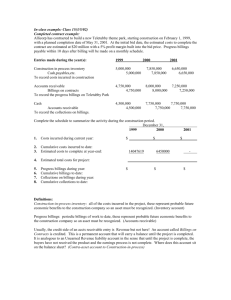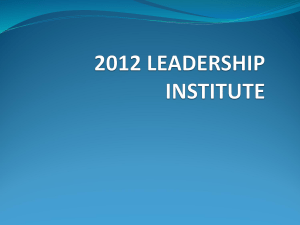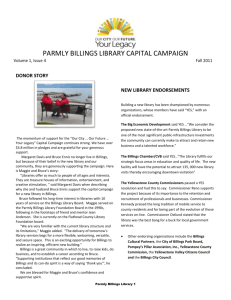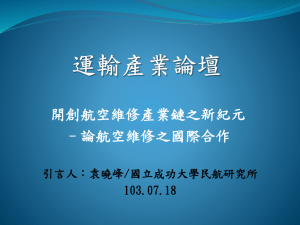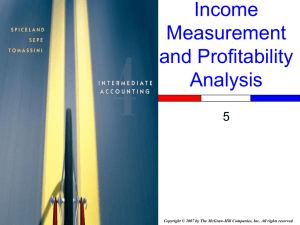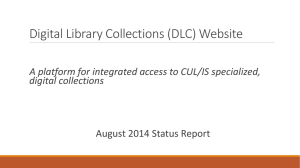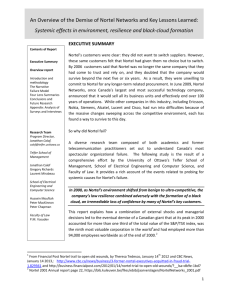Slides
advertisement
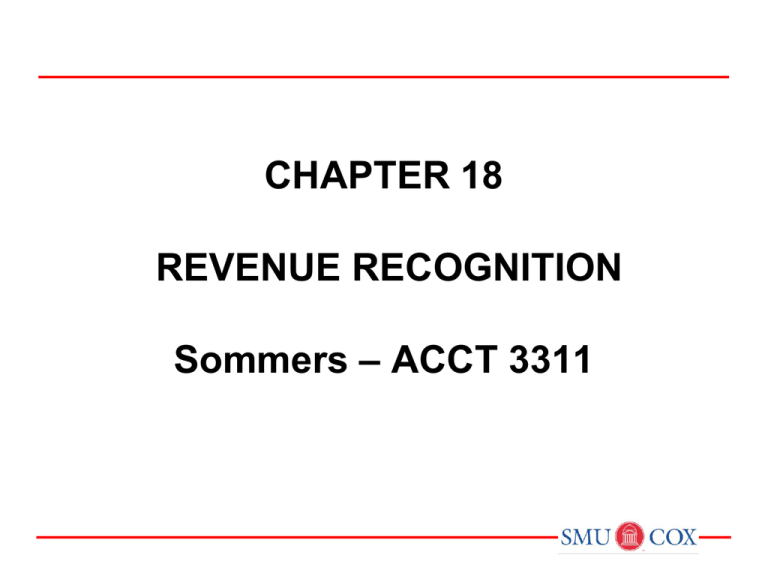
CHAPTER 18 REVENUE RECOGNITION Sommers – ACCT 3311 Guidelines for Revenue Recognition What are the two general criteria that must be satisfied before a company can recognize revenue? The realization principle requires that two criteria be satisfied before revenue can be recognized: 1. When it is realized or realizable – there is reasonable certainty as to the collectibility of the asset to be received (usually cash). 2. When it is earned– the earnings process is judged to be complete or virtually complete. Discussion Question Q18-2 What is viewed as a major criticism of GAAP as regards to revenue recognition? Revenue Recognition Matters • Revenue recognition is a top fraud risk and regardless of the accounting rules followed (IFRS or U.S. GAAP), the risk or errors and inaccuracies in revenue reporting is significant. • Restatements for improper revenue recognition are relatively common and can lead to significant share price adjustments. Messing with Revenue “Trade loading is a crazy, uneconomic, insidious practice through which manufacturers—trying to show sales, profits, and market share they don’t actually have—induce their wholesale customers, known as the trade, to buy more product than they can promptly resell.” A similar practice is referred to as channel stuffing. When a software maker needed to make its financial results look good, it offered deep discounts to its distributors to overbuy, and then recorded revenue when the software left the loading. Rev Rec at Point of Sale (Delivery) • Companies usually meet the two conditions for recognizing revenue by the time they deliver products or render services to customers. • Implementation problems – Sales with Discounts – Sales When Right of Return – Sales with Buybacks – Bill and Hold Sales – Principal-Agent Relationships – Trade Loading and Channel Stuffing – Multiple-Deliverable Arrangements Multiple-Deliverable Arrangements • MDAs provide multiple products or services to customers as part of a single arrangement. • The major accounting issues related to this type of arrangement are how to allocate the revenue to the various products and services and how to allocate the revenue to the proper period. • All units in a multiple-deliverable arrangement are considered separate units of accounting, provided that: – A delivered item has value to the customer on a standalone basis; and – The arrangement includes a general right of return relative to the delivered item; and – Delivery or performance of the undelivered item is considered probable and substantially in the control of the seller. Overview of New Revenue Rec Standard • In 2013, the FASB and IASB issued a converged standard on revenue recognition entitled Revenue from Contracts with Customers. Overview of Revenue Recognition • Revenue from Contracts with Customers, adopts an asset-liability approach. Companies: – Account for revenue based on the asset or liability arising from contracts with customers. – Are required to analyze contracts with customers • Contracts indicate terms and measurement of consideration. • Without contracts, companies cannot know whether promises will be met. New Revenue Recognition Standard • Key Concepts of Revenue Recognition Performance Obligation is Satisfied The Five-Step Process Assume that Boeing Corporation signs a contract to sell airplanes to Delta Air Lines for $100 million. Step 1: Identify the contract with customers. A contract is an agreement between two parties that creates enforceable rights or obligations. In this case, Boeing has signed a contract to deliver airplanes to Delta. Step 2: Identify the separate performance obligations in the contract. A Boeing has only one performance obligation—to deliver airplanes to Delta. If Boeing also agreed to maintain the planes, a separate performance obligation is recorded for this promise. The Five-Step Process Step 3: Determine the transaction price. Transaction price is the amount of consideration that a company expects to receive from a customer in exchange for transferring a good or service. In this case, the transaction price is straightforward—it is $100 million. Step 4: Allocate the transaction price to the separate performance obligations. In this case, Boeing has only one performance obligation—to deliver airplanes to Delta. The Five-Step Process Step 5: Recognize revenue when each performance obligation is satisfied. Boeing recognizes revenue of $100 million for the sale of the airplanes to Delta when it satisfies its performance obligation—the delivery of the airplanes to Delta. LO 2 Revenue Rec Articles – WSJ and CFO • What is effective date? • What should firms be aware of? • What should investors be aware of? Discussion Questions Q18-14 What are the two basic methods of accounting for long-term construction contracts? Indicate the circumstances that determine when one or the other should be used. Discussion Questions Q18-14 What are the two basic methods of accounting for long-term construction contracts? Indicate the circumstances that determine when one or the other should be used. Revenue Recognition Before Delivery Most notable example is long-term construction contract accounting. Two Methods: Percentage-of-Completion Method. ► Rationale is that the buyer and seller have enforceable rights. Completed-Contract Method. Percentage-of-Completion Method Must use when estimates of progress toward completion, revenues, and costs are reasonably dependable and all of the following conditions exist: 1. Contract clearly specifies the enforceable rights regarding goods or services by the parties, the consideration to be exchanged, and the manner and terms of settlement. 2. Buyer can be expected to satisfy all obligations. 3. Contractor can be expected to perform under the contract. Percentage-of-Completion Method Formula for Total Revenue to Be Recognized to Date Percentage-of-Completion Example Assume Nortel Networks contracted to provide a customer with Internet infrastructure for $2,000,000. The project began in 2011 and was completed in 2012. Data relating to the contract are summarized below: 2011 2012 Costs incurred during the year $ 300,000 $1,575,000 Estimated costs to complete as of 12/31 1,200,000 –0– Billings during the year 380,000 1,620,000 Cash collections during the year 250,000 1,750,000 2011 Percentage-of-Completion Example Cont. Assume Nortel Networks contracted to provide a customer with Internet infrastructure for $2,000,000. The project began in 2011 and was completed in 2012. Data relating to the contract are summarized below: 2011 2012 Costs incurred during the year $ 300,000 $1,575,000 Estimated costs to complete as of 12/31 1,200,000 –0– Billings during the year 380,000 1,620,000 Cash collections during the year 250,000 1,750,000 Gross profit recognition: Balance Sheet: Percentage-of-Completion Example Cont. Assume Nortel Networks contracted to provide a customer with Internet infrastructure for $2,000,000. The project began in 2011 and was completed in 2012. Data relating to the contract are summarized below: 2011 2012 Costs incurred during the year $ 300,000 $1,575,000 Estimated costs to complete as of 12/31 1,200,000 –0– Billings during the year 380,000 1,620,000 Cash collections during the year 250,000 1,750,000 2012 Percentage-of-Completion Example Cont. Assume Nortel Networks contracted to provide a customer with Internet infrastructure for $2,000,000. The project began in 2011 and was completed in 2012. Data relating to the contract are summarized below: 2011 2012 Costs incurred during the year $ 300,000 $1,575,000 Estimated costs to complete as of 12/31 1,200,000 –0– Billings during the year 380,000 1,620,000 Cash collections during the year 250,000 1,750,000 Gross profit recognition: Balance Sheet: Completed-Contract Method Companies should use when one of the following conditions applies when: 1. Company has primarily short-term contracts, or 2. Company cannot meet the conditions for using the percentage-of-completion method, or 3. There are inherent hazards in the contract beyond the normal, recurring business risks. Completed Contract Example Assume Nortel Networks contracted to provide a customer with Internet infrastructure for $2,000,000. The project began in 2011 and was completed in 2012. Data relating to the contract are summarized below: 2011 2012 Costs incurred during the year $ 300,000 $1,575,000 Estimated costs to complete as of 12/31 1,200,000 –0– Billings during the year 380,000 1,620,000 Cash collections during the year 250,000 1,750,000 2011 Completed Contract Example Assume Nortel Networks contracted to provide a customer with Internet infrastructure for $2,000,000. The project began in 2011 and was completed in 2012. Data relating to the contract are summarized below: 2011 2012 Costs incurred during the year $ 300,000 $1,575,000 Estimated costs to complete as of 12/31 1,200,000 –0– Billings during the year 380,000 1,620,000 Cash collections during the year 250,000 1,750,000 Gross profit recognition: Balance sheet: Completed Contract Example Assume Nortel Networks contracted to provide a customer with Internet infrastructure for $2,000,000. The project began in 2011 and was completed in 2012. Data relating to the contract are summarized below: 2011 2012 Costs incurred during the year $ 300,000 $1,575,000 Estimated costs to complete as of 12/31 1,200,000 –0– Billings during the year 380,000 1,620,000 Cash collections during the year 250,000 1,750,000 2012 Completed Contract Example Assume Nortel Networks contracted to provide a customer with Internet infrastructure for $2,000,000. The project began in 2011 and was completed in 2012. Data relating to the contract are summarized below: 2011 2012 Costs incurred during the year $ 300,000 $1,575,000 Estimated costs to complete as of 12/31 1,200,000 –0– Billings during the year 380,000 1,620,000 Cash collections during the year 250,000 1,750,000 Gross profit recognition: Balance Sheet: Long-Term Contract Losses Loss in the Current Period on a Profitable Contract ► Percentage-of-completion method only, the estimated cost increase requires a current-period adjustment of gross profit recognized in prior periods. Loss on an Unprofitable Contract ► Under both percentage-of-completion and completedcontract methods, the company must recognize in the current period the entire expected contract loss.

